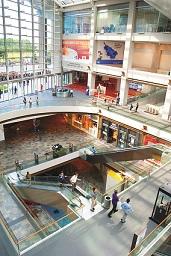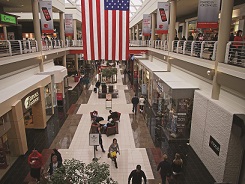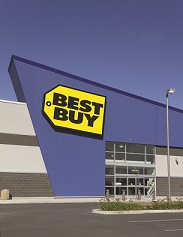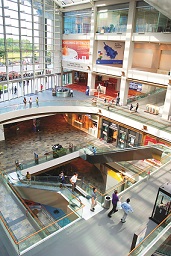

The last decade has seen vacancies skyrocket in many local shopping districts, strip malls and downtowns, while others have experienced stability and growth. These shifts have led a number of industry observers to forecast the end of retail, as we know it. Many predict retail will change more in the next five years than it has over the past century and that the extinction of brick-and-mortar stores isn’t far off.
A longer view is that big changes, in general, have occurred in the past; they are occurring now and by any measure, are inevitable. Simply put, retailers must stay attuned to shopping habits, the use of technology and utilization of analytics as a means of satisfying customer desires and boosting profits.
The retail historic timeline has seen local corner stores give way to department stores and supermarkets, then to suburban shopping malls, then to discount chains and big-box retailers. Each of these shifts unfolded faster than anticipated, and each elevated new retailers and replaced incumbents. Such rapid shifts in positions can be seen; since 1990, 60 percent of the 10 largest U.S. retailers have fallen from their positions while new offerings have emerged and assumed leadership positions.
Despite the rapidly changing methodology consumers use to make purchasing decisions, hence the advent of virtual retail outlets, the facts are that industry metamorphoses have actually occurred at a much slower rate than would appear. Most have occurred over decades, thus giving retailers of all sizes time to react. The projected reality is that in 2025, approximately 85 percent of U.S. retail sales will be done in brick-and-mortar stores (Source: ICSC).
While there appears to be time to adjust and develop new strategies, to be successful in the marketplace no business can wait to react. There are trends reshaping the retail consumer landscape and current retail operators must stay in touch with these winds of change or be swept away.
Demographic Trends
Economic indicators do not paint a rosy picture for retailers. Budget deficits are mounting, unemployment remains high and the average consumer’s balance sheet — while improving — remains unstable.
It has taken more than five years to recover the $16 trillion in net worth U.S. consumers lost from peak to trough in the recent recession. Rising social costs related to health care, taxes, higher education and other areas will continue to stress disposable income. Most industry forecasts suggest U.S. retail growth over the next five years will average three to four percent annually, well below the five to seven percent yearly growth seen in the decade prior to the recession.
Yet, within the overall nominal market, there are several pockets of strong growth. Today, three customer segments are projected to make disproportionate contributions to spending growth. For each unique segment, retailers must develop and implement targeted customer-centric strategies.
- Baby boomers. Some 47 million households headed by people over the age of 55 will account for the bulk of spending growth in major categories such as food (92 percent), housewares (73 percent), and apparel (56 percent). The segment’s sheer size will drive growth in these categories, but boomers will also disproportionally spend their disposable income on services and experiences instead of off-the-shelf products.
- Hispanic consumers. The retail spending of Hispanic consumers will nearly double over the next 10 years and account for almost one-fifth of total retail spending. Of important note, it has been documented that Hispanics spend money differently from other consumers. For example, they spend at least one and a half times more on children’s apparel, footwear and fresh food than non-Hispanic consumers do — and retailers will have to account for this accordingly.
- Millennials. People between the ages of 13 and 30 constitute 15 percent of U.S. consumers. Millennials are the first group that grew up after the Internet, social media and mobile became the norm — most have never known a world without them. They will account for nearly one-third of total spending by 2020. Even through the economic tumult of the past five years, the spending of millennials has grown by three percent a year.

As purchases migrate to digital channels, most retailers will need less physical selling space in stores. Although some formats (such as groceries) will be relatively unaffected, others (such as consumer electronics and toys) will be hit profoundly and could require square-footage reductions of half or more to deliver a compelling customer experience and economics. Retailers are already seeing this phenomenon, and a real estate rebalancing is under way as they reassess what should be sold through physical space; in 2012 alone, major chains shuttered approximately 4,500 stores in the United States, and newly opened stores are some 25 percent smaller than the average size of existing ones.
To win consumers’ loyalty, stores can’t simply be places where products happen to be sold. For many retailers, future store layouts will have to provide customers with greater opportunities for learning and experimentation. Available technology will need to be fully integrated into how store management and employees engage customers.
In short, the lines between physical and digital will continue to blur. The blurring of the traditional lines can be found in the fact that 40 percent of Best Buy’s (and more than 50 percent of Walmart’s) online purchases are picked up in stores. To make informed network choices, retailers must take a long-term view of their real estate footprint. Future store footprints, format, size and space allocations will shift how and where stores remain open or will close.
Regional malls will continue to be institutional assets. Despite the recent real estate slump and vacancies, there is still a strong need for strip centers. According to a recent study by CRBE Econometric Advisors, vacancy in strip and community centers fell by 30 basis points in 2012 and at the beginning of 2013 sat at 12.8 percent nationwide. Hot strip mall tenants include:
- Frozen yogurt
- Locally made goods
- Furniture stores and home décor
- Pressed juices
- Waxing and treading.
Concluding Trends
As the U.S. economy slowly climbs out of the recession, a better job market and increased home values finally have consumers spending again. While October retail sales ticked up 0.6 percent, today's consumer is not the same shopper who was in the malls in 2008.
Based on a recent Nielsen study, more than 70 percent of shoppers still feel like they're in a recession and are shopping less than they did five years ago.
 The consumer attitude isn’t the only thing changing. There are fundamental shifts in the way 2014 consumers make purchasing decisions. The use of technology for both shopping and making purchases will accelerate. Driving this equation are the following factors:
The consumer attitude isn’t the only thing changing. There are fundamental shifts in the way 2014 consumers make purchasing decisions. The use of technology for both shopping and making purchases will accelerate. Driving this equation are the following factors:
- Mobile purchasing is moving from desktop and laptop to buying via their phone or tablet. In 2013, mobile shopping accounted for 17 percent of Cyber Monday shopping, a 55 percent increase over 2012, according to IBM. Experts expect the shift to mobile devices to accelerate even faster in 2014.
- The lag between order and getting purchased product into the hands of the consumer will decrease as most online retailers have focused on reducing shipping times. Amazon offers 48-hour shipping to its Prime customers, and now the shipping giant, along with competitors like Walmart and Google, are testing same-day delivery in some markets. Other retailers like Best Buy allow customers to pick up an item in-store within a few hours of placing an order.
- Mass customization is becoming a standard as advances in manufacturing and other technology are allowing more retailers to offer customer centered, personalized everything from cell phone covers to sneakers. The ability for customers to create products to their exact specifications, including colors, size and features, has proven that buyers will pay a premium for personalized items.
- New outlet stores abound. Today's consumer is both brand-aware and cost-conscious, making him or her an ideal outlet store shopper, and developers and retailers have taken note. This trend is best illustrated by the fact that more than half of all Saks stores are now outlets, and 13 of the 15 planned stores for the next two years will be outlet stores. Nordstrom is planning 30 more Nordstrom Rack stores in 2014.
- Although making mobile wallets mainstream is not yet a mainstream trait, their acceptance at major retailers and by consumers will continue to grow next year. Experts expect many of the startup mobile wallet players to consolidate this year, leaving a few big players — like PayPal and Google — to make inroads with shoppers. Early adopters may score some great perks or incentives for testing out the technology.
- Department stores and other large retailers like Best Buy have found that bigger isn't always better. The realization lies in that even the biggest store can't compete with the offerings of a virtual warehouse like Amazon. Accelerating the shift is a trend among consumers away from malls and back to traditional urban centers and smaller downtown "Main Street" type areas that don't accommodate 40,000 square-foot storefronts.
- Couponing will go high-tech. The post-recession consumer is still spending carefully and looking for ways to stretch his or her dollar. McKinsey & Co reports that 51 percent of consumers are using coupons more. But today's coupon users aren't clipping the Sunday circulars or even searching online for the best coupon. Instead, they're putting technology to work for them with tools like the web-based Coupons at Checkout, which automatically scans the web to give you a relevant discount code before you make a purchase, or Shopular, a mobile app that automatically sends your phone coupons when you walk into a store.
- The move toward locally sourced items has taken firm root in the food space; both in restaurants and at grocery stores, but now the trend is expanding into the broader retail space. More than a third of consumers this holiday season planned to shop at small, local businesses, up from about 25 percent in 2012, according to Deluxe Corp. This shift reflects growing demand for unique products and personalized service, as well as the awareness that shopping local can boost one's home economy.
- User experience is a critical consideration for retailers trying to increase their bottom line. This “touch point” is the most intimate and emotional interaction customers can have with your brand. If it’s a good experience, you will increase brand loyalty and equity. Another key facet of a compelling customer experience is found in offering more in the way of one-on-one, interactive product demonstrations. These experiences are unique to your customers and will remain with them far longer than an online interaction ever will” says Greg Fullington of Imagine Nation, a full-service marketing and branding agency.
- Retailers both large and small are expanding their use of big data. Its use brings more dynamic pricing designed to maximize profits. The process, including the use of pricing models for both online and in-store, allows them to do this in a more relevant and real-time manner. In addition to shifting prices based on demand, retailers will use geo-targeting and other technology to maximize prices based on both geographic and consumer-purchasing history.
Thus, changing demographics, shopping habits and digital purchasing are making their way toward a brave new retailing world.

